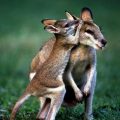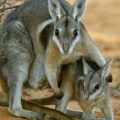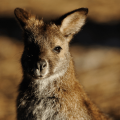Wallabies are far from being mysterious animals, which may lead people to believe they know everything about these cute animals, after all, they look and kind of act like kangaroos. However, like kangaroos, there are many different species of wallabies, and though they may have similar characteristics, each has their own unique identity that makes them special. Here are five facts not many people know about wallabies.
They Are Furless and Pink at Birth
Like kangaroos and many marsupials, newborn wallabies (also called joey), are furless, pink and blind. They’re about the same size of jellybeans, quite tiny, and look helpless. After a month or so of gestation, they reach the pouch of their mother. They’re attached to their mother through a teat, and suckle it for the next 6 or 7 months.
The joey will stay attached to its mother’s pouch until they are able to develop and become independent. They may spend some time outside their pouch, but quickly jump back in the second they sense danger. It will take about 9 months for a joey to become fully independent.
They Can Swim
Like kangaroos, wallabies are actually good swimmers. They use their hind legs to kick through the water independently, and swim using ‘dog’ paddle motion. This is quite interesting, as they often can’t use their legs on land, independently. They swim mostly at dusk, especially the Swamp Wallaby.
Nurturing Mother Wallabies Can Make 2 Types of Milk
This is another amazing fact about wallabies –wallabies (the female of course) have a remarkable ability to make two different types of milk simultaneously – they produce a type of milk suitable for developing joey on one nipple, and another type of milk for larger joey on the other nipple. Each type of milk has its own different lipid composition, protein and carbs. Milk for bigger joey is higher in fat content, which is essential for its more active lifestyle.
This is because it is common for female wallabies to take care of three young joeys simultaneously; with one as an inseminated egg in its uterus, the other being suckled on its pouch, and a third one which is more active, and has already left the pouch, but climbs back to suckle from time to time.
They Communicate by Thumping
Wallabies prefer to use olfactory and visual signals for communications, though they can also use auditory and even tactile methods. When sensing danger, they froze up and make thumping noises with their foot to warn the other of the potential threat. They can also make hissing and snorting sound.
Birds, Other Predatory Animals and Even Humans Hunt Them Down
Because they’re relatively small, wallabies are automatic preys when it comes to mapping up the food chain in the wild. Dingoes, Tasmanian devils, European foxes, eagles (i.e. wedge-tailed), snakes, and cats, and dogs hunt them as preys. Humans, often consider them as pests in their farm, to protect forests, or through road kills, especially when their population is in boom. As a matter of fact, like kangaroos, wallabies account as one of the highest number of wildlife killed on the roads of Australia.






 Author and long-time animal lover. Sharing knowledge on pet care through experience and the written word.
Author and long-time animal lover. Sharing knowledge on pet care through experience and the written word.